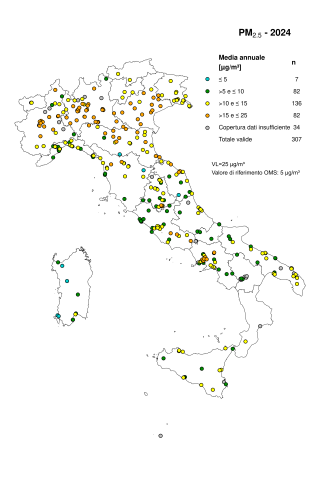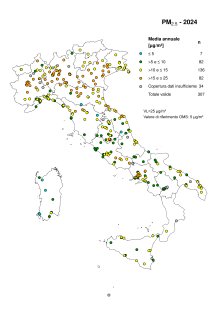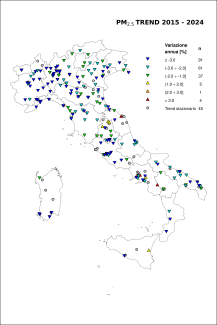Panel 1
Giorgio Cattani, Mariacarmela Cusano, Alessandro Di Menno di Bucchianico, Raffaela Gaddi, Alessandra Gaeta, Giuseppe Gandolfo, Gianluca Leone
The indicator is based on PM concentration data 2,5 in the atmosphere measured during 2024 in monitoring stations distributed across the national territory, collected and archived in ISPRA in the InfoAria database, in accordance with the provisions of Directive 2008/50/EC (and the legislative decree transposing Legislative Decree 155/2010 and subsequent amendments) and Decision 2011/850/EU. The monitoring stations that measured and reported PM data 2,5 are 341, of these, 207 have data series with sufficient time coverage for the verification of the reference values are 307. The annual limit value of the PM 2,5 (25 µg/m³) is respected in all cases. However, in the majority of monitoring stations, the WHO annual reference value of 5 µg/m³ is exceeded (97.7% of cases).
Airborne particulate matter refers to all solid and liquid atmospheric particles suspended in ambient air. The term PM 2,5 identifies particles with an aerodynamic diameter (d. a.) less than or equal to 2.5 µm.
Given their small size, once inhaled, they penetrate deep into the human respiratory system and, overcoming the tracheo-bronchial barrier, reach the alveolar area.
PM particulate matter 2,5 it is also called 'fine particulate', a name contrasted with 'coarse particulate' which indicates all those particles suspended with d. a. Greater than 2.5 µm or, within the PM fraction 10, those with d. a. Between 2.5 and 10 µm.
The direct emission of fine particulate matter is associated with all combustion processes, in particular those that involve the use of solid fuels (coal, wood) or petroleum distillates with a medium-high number of carbon atoms (diesel, fuel oil). Fine particles are therefore emitted by the exhaust gases of internal combustion vehicles, energy production plants and combustion processes in industry, home heating systems and fires.
The mass concentration of PM 2,5 it is dominated by accumulation mode particles, i. e. Those particles in the size range from approximately 0.1 µm to approximately 1 µm characterized by long residence times in the atmosphere. Secondary particulate matter, formed in the atmosphere starting from precursor gases or due to aggregation phenomena of smaller particles, or by condensation of gas on particles that act as clots, can represent a significant portion of the observed mass concentration.
The indicator was developed based on PM concentration data 2,5 in the atmosphere, measured in monitoring stations distributed throughout the national territory, collected and archived in ISPRA in the InfoAria database in accordance with the provisions of Decision 2011/850/EU. The parameters were calculated for a comparison with the limit values for the protection of human health established by the reference legislation (Legislative Decree 155/2010 and subsequent amendments) and with the reference values established by the WHO for the protection of human health (WHO-AQG, 2021), average, 5°, 25°, 50°, 75°, 90.4°, 95° and 99th percentile and maximum of the daily average values.
Provide information on the state of air quality through statistical parameters calculated from concentration data in ambient air. Carry out verification of compliance with the limit values established by law and comparison with the reference values established by the WHO.
Commission Implementing Decision 2011/850/EU, of 12 December 2011, containing provisions for the implementation of Directives 2004/107/EC and 2008/50/EC of the European Parliament and of the Council regarding the mutual exchange and communication of information on ambient air quality. The objective of Directive 2008/50/EC is to allow the assessment of air quality on a common basis, to obtain information on the state of air quality in order to combat air pollution, to ensure the public availability of information and to promote cooperation between Member States.
Legislative Decree 155/2010, which implements the aforementioned directive at a national level, also has the objective of allowing autonomous regions and provinces to evaluate and manage ambient air quality.
The limit values of Legislative Decree 155/2010 represent the ambient air quality objectives to be pursued to avoid, prevent and reduce harmful effects on human health and the environment as a whole. For PM particulate matter 2,5 are the following:
• for the averaging period of one calendar year the limit value is 25 µg/m 3.
The WHO reference values represent a guide to be followed in reducing the impact of air pollution on human health, indicated in WHO global air quality guidelines 2021. For the mediation period of one calendar year they are as follows:
• for long-term human exposure it is 5 µg/m 3;
• for short-term human exposure it is 15 µg/m 3 not to exceed more than three days per year.
Panel 2
ISPRA. (various editions). Environmental data yearbook.
SNPA. (2024). Air quality in Italy. 2023 edition.
World Health Organization. (2000). Air quality guidelines for Europe; second edition . Copenhagen: WHO Regional Office for Europe.
Data quality assessment
Autonomous Provinces, Regions, SNPA (National System for Environmental Protection)
Databases InfoAria - ISPRA
National
Regional: (20/20)
Provincial: (101/110)
Municipal: (254/8047)
2015-2024
Indicator assessment
The indicator is based on PM concentration data 2,5 in the atmosphere, measured in monitoring stations distributed throughout the national territory, collected and archived in ISPRA, in databases InfoAria in accordance with the provisions of Decision 2011/850/EU. The parameters were calculated for a comparison with the limit values for the protection of human health established by the reference legislation (Legislative Decree 155/2010) and with the reference values established by the WHO for the protection of human health. All parameters were calculated following European rules and were subjected to verification by the Regions/PPAA/ARPA/APPA. For the comparison with the annual limit value of Legislative Decree 155/2010 and with the WHO reference value, data series with a minimum time coverage of 90% were used (net of data losses due to periodic calibration or ordinary maintenance).
The statistical analysis of trend (2015-2024) was conducted with the seasonally corrected Mann-Kendall method. Implementing a seasonal adjustment method allows you to minimize the effect of interannual fluctuations due to the differences found in the various years compared to the average seasonal cycle, to highlight the existence of an underlying trend, to quantify its statistical significance
The annual PM limit value 2,5 (25 µg/m³) is respected in all stations. However, the WHO annual reference value is exceeded in most monitoring stations (97.7% of cases, Figure 2).
For the PM 2,5 a is observed trend decreasing statistically significant in 77% of cases (189 monitoring stations out of 244), with estimated average annual variation: -0.6 µg/m³y [-1.8 µg/m³y ÷ -0.1 µg/m³y]). On the portion of the sample considered for which a trend statistically significantly decreasing, an average annual reduction of 3.1% (-8.2% ÷ -1.0%) is observed (Table 3, Figures 3 and 4).
Data
Figure 3: PM2,5 – Spatial distribution of the analysed monitoring stations and estimated average annual percentage change in concentration
Processing by ISPRA based on SNPA data
Results of the trend analysis using the seasonality-adjusted Kendall test on a sample of 244 monitoring stations (2015–2024).
Figura 4: PM2,5 - Distribuzione percentuale delle stazioni di monitoraggio in base all’andamento del trend osservato nel periodo 2015-2024
Elaborazione ISPRA su dati SNPA
p≤ 0,05: il trend osservato è statisticamente significativo p>0,05: non può essere esclusa l'ipotesi nulla (assenza di trend)
Sintesi dei risultati dell’analisi del trend (2015 - 2024) con il test di Kendall corretto per la stagionalità delle concentrazioni di PM2,5 in Italia su una selezione di 244 stazioni di monitoraggio distribuite sul territorio nazionale.
Table 1 – PM2,5: Monitoring stations – data and statistical parameters for air quality assessment (2024).
Processing by ISPRA based on SNPA data
“1” Zone type: U = Urban; S = Suburban; R = Rural
“2” Station type: T = Traffic; B = Background; I = Industrial
“3” Values shown in bold are reported on the map. Values are highlighted in bold only for data series with at least 90% valid data, net of losses due to periodic calibration or routine maintenance, in accordance with the quality criteria defined by current legislation (Legislative Decree 155/2010).
“–” Value not calculated due to lack of data.
Table 2 – PM2,5: Classification of zones with respect to assessment thresholds and verification of exceedances of the annual limit value in accordance with Legislative Decree 155/2010 (2024)
Processing by ISPRA based on SNPA data
Zone: a delimited portion of the national territory, as defined by Legislative Decree 155/2010, for the purposes of ambient air quality assessment and management;
Agglomeration: a zone consisting of an urban area or a group of urban areas located no more than a few kilometres apart, or of a main urban area together with a set of smaller urban areas that depend on the main one in terms of population, services, and flows of people and goods, having:
- a population greater than 250,000 inhabitants; or
- a population lower than 250,000 inhabitants and a population density per km² greater than 3,000 inhabitants.
Annual limit value (LV) exceedance: an exceedance is considered to have occurred when it is detected at least at one monitoring station located within the territory of the zone.
Classification:
- aboveUAT: above the upper assessment threshold (70% of the limit value, 17 μg/m³);
- LAT–UAT: between the lower assessment threshold and the upper assessment threshold;
- belowLAT: below the lower assessment threshold (50% of the limit value, 12 μg/m³).
Note: Exceedance of the upper and lower assessment thresholds shall be determined on the basis of ambient air pollutant concentrations over the five preceding calendar years. An exceedance is considered to occur if the assessment threshold has been exceeded in at least three of the five preceding calendar years.
(a) Exceedance assessment obtained through modelling
Table 3 – PM2,5: Trend analysis by monitoring station (2015–2024)
Processing by ISPRA based on SNPA data
p ≤ 0.05: the observed trend is statistically significant
p > 0.05: the null hypothesis (no trend) cannot be rejected
Δy: estimated average annual change based on the results of the seasonality-adjusted Kendall test





The monitoring stations that measured and reported PM data 2,5 there are 341. Of these, 307 (90.0% of the total) have a minimum time coverage of 90% (net of data losses due to periodic calibration or ordinary maintenance) (Table 1). The classification of PM monitoring stations 2,5 according to the macroscale location criteria envisaged by the legislation, it is represented in Figure 1. The annual limit value (25 µg/m³) was not exceeded in any case. The annual WHO reference value (5 µg/m³) was exceeded in 300 stations (97.7% of cases) (Figure 2).
There were no exceedances of the limit value in any area (Table 2).